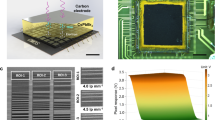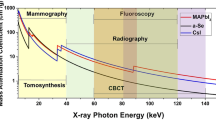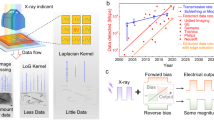Abstract
X-ray imaging technologies such as digital radiography (DR), is an important aspect of modern non-destructive testing and medical diagnosis. Innovative flexible X-ray detector technologies have recently been proposed and are now receiving increasing attention owing to their superior material flexibility compared with traditional flat-panel detectors. This work aims to study these innovative flexible X-ray detectors in terms of their effectiveness in DR imaging, such as detection efficiency and spatial resolution. To achieve this goal, first, a Monte Carlo model was developed and calibrated to an in-lab 150 kV DR imaging system containing a flat-panel X-ray detector. Second, the validated model was updated with various types of flexible X-ray detectors to assess their performance in nearly realistic conditions. Key parameters such as the detection efficiency pertaining to the crystal material and thickness were studied and analyzed across a broader energy range up to 662 keV. Finally, the imaging performance of the different detectors was evaluated and compared to that of the flat-panel detector in the 150 kV DR imaging system. The results show that the flexible detectors such as the CsPbBr3 crystal detector deliver promising performance in X-ray imaging and can be applied to a wider range of application scenarios, especially those requiring accurate detection at challenging angles.












Similar content being viewed by others
Data availability
The data that support the findings of this study are openly available in Science Data Bank at https://www.doi.org/10.57760/sciencedb.j00186.00073 and http://cstr.cn/31253.11.sciencedb.j00186.00073.
References
H. Liang, S. Cui, R. Su et al., Flexible X-ray detectors based on amorphous Ga2O3 thin films. ACS Photonics 6(2), 351–359 (2018). https://doi.org/10.1021/acsphotonics.8b00769
D. Mery, Computer Vision for X-Ray Testing, vol. 10 (Springer, Switzerland, 2015). https://doi.org/10.1007/978-3-319-20747-6
W. Zhao, D. Hunt, K. Tanioka et al., Amorphous selenium flat panel detectors for medical applications. Nucl. Instrum. Meth. Phys. Res. Sect. A 549(1–3), 205–209 (2005). https://doi.org/10.1016/j.nima.2005.04.053
X. Ou, X. Chen, X. Xu et al., 2021 Recent development in X-ray imaging technology: future and challenges. Research 2021, 9892152 (2021). https://doi.org/10.34133/2021/9892152
S. Cherry, M. Dahlbom, PET: physics, instrumentation, and scanners, in PET (Springer, New York, NY, 2006), p. 1–117. https://doi.org/10.1007/978-0-387-22529-6_1
Z. Yang, J. Hu, D. Van der Heggen et al., Realizing simultaneous X-Ray imaging and dosimetry using phosphor-based detectors with high memory stability and convenient readout process. Adv. Funct. Mater. 32, 2201684 (2022). https://doi.org/10.1002/adfm.202201684
Z. Yang, Q. Xu, X. Wang et al., Large and ultrastable all-inorganic CsPbBr 3 monocrystalline films: low-temperature growth and application for high-performance photodetectors. Adv. Mater. 30(44), 1802110 (2018). https://doi.org/10.1002/adma.201802110
J. Guo, Y. Xu, W. Yang et al., High-stability flexible X-ray detectors based on lead-free halide perovskite Cs2TeI6 films. ACS Appl. Mater. Interfaces 13(20), 23928–23935 (2021). https://doi.org/10.1021/acsami.1c04252
A. Ciavatti, R. Sorrentino, L. Basiricò et al., High-sensitivity flexible X-ray detectors based on printed perovskite inks. Adv. Funct. Mater. 31(11), 2009072 (2021). https://doi.org/10.1002/adfm.202009072
A.J.J.M. van Breemen, M. Simon, O. Tousignant et al., Curved digital X-ray detectors. NPJ Flex. Electron. 4(1), 22 (2020). https://doi.org/10.1038/s41528-020-00084-7
M. Roknuzzaman, K. Ostrikov, H. Wang et al., Towards lead-free perovskite photovoltaics and optoelectronics by ab-initio simulations. Sci. Rep. 7(1), 14025 (2017). https://doi.org/10.1038/s41598-017-13172-y
J. Choi, B. Park, C. Ha et al., Improving the light collection using a new NaI (Tl) crystal encapsulation. Nucl. Instrum. Meth. Phys. Res. Sect. A 981, 164556 (2020). https://doi.org/10.1016/j.nima.2020.164556
T. Kuo, C. Wu, H. Lu et al., Flexible X-ray imaging detector based on direct conversion in amorphous selenium. J. Vac. Sci. Technol. A 32(4), 041507 (2014). https://doi.org/10.1116/1.4882835
W. Lü, X. Wei, Q. Wang et al., New flexible CsPbBr 3-based scintillator for X-ray tomography. Nucl. Sci. Tech. 33(8), 98 (2022). https://doi.org/10.1007/s41365-022-01085-z
Y. Xu, A. Ying, J. Peng et al., Hybrid perovskite X-ray detectors with enhanced radio luminescence via thermally activated delayed fluorescence. Sci. China Mater. 66, 724–732 (2022). https://doi.org/10.1007/s40843-022-2193-6
X. Huang, H. Liu, J. Zhang et al., Simulation and photoelectron track reconstruction of soft X-ray polarimeter. Nucl. Sci. Tech. 32, 67 (2021). https://doi.org/10.1007/s41365-021-00903-0
G. Knoll, Radiation Detection and Measurement, 4th ed (Wiley, 2010). ISBN-10.978-0-470-131480
Y. Wang, J. Liang, Q. Zhang et al., Development and verification of Geant4-based parallel computing Monte Carlo simulations for nuclear logging applications. Ann. Nucl. Energy 172, 109079 (2022). https://doi.org/10.1016/j.anucene.2022.109079
X. Wang, J. Liang, Y. Li et al., Hybrid Monte Carlo methods for Geant4-based nuclear well logging implementation. Ann. Nucl. Energy 169, 108824 (2022). https://doi.org/10.1016/j.anucene.2021.108824
S. Agostinelli, J. Allison, K. Amako et al., GEANT4—a simulation toolkit. Nucl. Instrum. Meth. Phys. Res. Sect. A 506(3), 250–303 (2003). https://doi.org/10.1016/S0168-9002(03)01368-8
J. Allison, K. Amako, J. Apostolakis et al., Geant4 developments and applications. IEEE Trans. Nucl. Sci. 53(1), 270–278 (2006). https://doi.org/10.1109/TNS.2006.869826
J. Allison, Recent developments in Geant4. Nucl. Instrum. Meth. Phys. Res. Sect. A 835, 186–225 (2016). https://doi.org/10.1016/j.nima.2016.06.125
K. Cranley, B. Gilmore, G. Fogarty et al., Catalogue of Diagnostic X-ray Spectra and Other Data. IPEM Report No. 78 (The Institute of Physics and Engineering in Medicine, York, UK, 1997)
ICRP, Conversion coefficients for use in radiological protection against external radiation. ICRP 74. Ann. ICRP 26, 159–179 (1996)
Y. Liu, B. Wei, Y. Xu et al., Feasibility study on determining the conventional true value of gamma-ray air kerma in a minitype reference radiation. Nucl. Sci. Tech. 28(6), 80 (2017). https://doi.org/10.1007/s41365-017-0236-5
S. Bouzit, L. MacDonald, Colour difference metrics and image sharpness, in Color and Imaging Conference, Vol. 2000, No. 1 (Society for Imaging Science and Technology, 2000), p. 262–267 (2000)
C. Zhang, X. Pan, J. Ding et al., Simulation study on characteristics of information extraction in multiple-image radiography. Nucl. Sci. Tech. 29, 72 (2018). https://doi.org/10.1007/s41365-018-0403-3
M. Guthoff, O. Brovchenko, W. De Boer et al., Geant4 simulation of a filtered X-ray source for radiation damage studies. Nucl. Instrum. Meth. Phys. Res. Sect. A 675, 118–122 (2012). https://doi.org/10.1016/j.nima.2012.01.029
Y. He, L. Matei, H. Jung et al., High spectral resolution of gamma-rays at room temperature by perovskite CsPbBr 3 single crystals. Nat. Commun. 9, 1609 (2018). https://doi.org/10.1038/s41467-018-04073-3
A. Cowen, S. Kengyelics, A. Davies et al., Solid-state, flat-panel, digital radiography detectors and their physical imaging characteristics. Clin. Radiol. 63(5), 487–498 (2008). https://doi.org/10.1016/j.crad.2007.10.014
J.-Y. Rong, G.-T. Fu, C.-F. Wei et al., Measurement of spatial resolution of the micro-CT system. Chin. Phys. C 34, 412 (2010). https://doi.org/10.1088/1674-1137/34/3/022
A. Mittal, A. Moorthy, A. Bovik et al., No-reference image quality assessment in the spatial domain. IEEE Trans. Image Proc. 21(12), 4695–4708 (2012). https://doi.org/10.1109/TIP.2012.2214050
A. Anam, T. Fujibuchi, F. Haryanto et al., Automated MTF measurement in CT images with a simple wire phantom. Polish J. Med. Phys. Eng. 25(3), 179–187 (2019). https://doi.org/10.2478/pjmpe-2019-0024
Z. He, N. Huang, P. Wang et al., Spatial resolution and image processing for pinhole camera-based X-ray fluorescence imaging: a simulation study. Nucl. Sci. Tech. 33(5), 64 (2022). https://doi.org/10.1007/s41365-022-01036-8
Author information
Authors and Affiliations
Contributions
All authors contributed to the study conception and design. Material preparation, data collection and analysis were performed by Yang Wang and Qiong Zhang. The first draft of the manuscript was written by Yang Wang, and all authors commented on previous versions of the manuscript. All authors read and approved the final manuscript.
Corresponding author
Ethics declarations
Conflict of interest
The authors declare that they have no competing interests.
Additional information
This work was supported by the China Natural Science Fund (No.52171253) and Natural Science Foundation of Sichuan (No. 2022NSFSC0949).
Rights and permissions
Springer Nature or its licensor (e.g. a society or other partner) holds exclusive rights to this article under a publishing agreement with the author(s) or other rightsholder(s); author self-archiving of the accepted manuscript version of this article is solely governed by the terms of such publishing agreement and applicable law.
About this article
Cite this article
Wang, Y., Zhang, Q. A characterization study on perovskite X-ray detector performance based on a digital radiography system. NUCL SCI TECH 34, 69 (2023). https://doi.org/10.1007/s41365-023-01220-4
Received:
Revised:
Accepted:
Published:
DOI: https://doi.org/10.1007/s41365-023-01220-4




